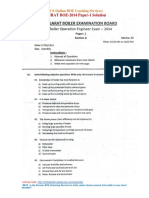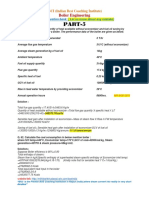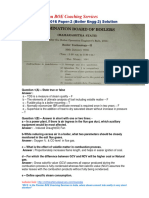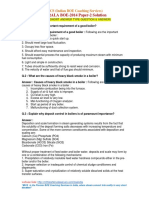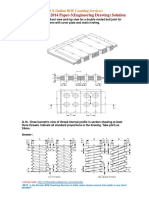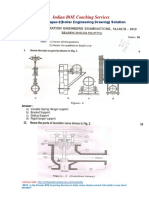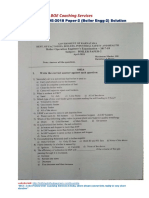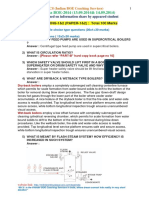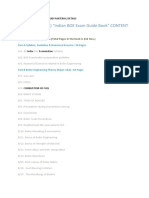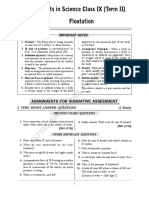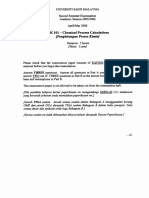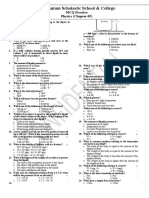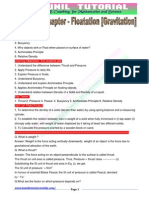Gujarat BOE 2013 Paper 1 Solution
Gujarat BOE 2013 Paper 1 Solution
Uploaded by
padmashree sonawaneCopyright:
Available Formats
Gujarat BOE 2013 Paper 1 Solution
Gujarat BOE 2013 Paper 1 Solution
Uploaded by
padmashree sonawaneCopyright
Available Formats
Share this document
Did you find this document useful?
Is this content inappropriate?
Copyright:
Available Formats
Gujarat BOE 2013 Paper 1 Solution
Gujarat BOE 2013 Paper 1 Solution
Uploaded by
padmashree sonawaneCopyright:
Available Formats
Indian BOE Coaching Services
Gujarat BOE-2013 Paper-1 (Boiler Engg-1) Solution
Q. 1(a) : A boiler of 20.43 m3 capacity generate steam at pressure of 8 bar where
2/3rd volume is occupied by water and 1/3rd volume by steam. The explosion takes
place. Calculate the energy released due to explosion if the period of explosion is
one second take density of water at 8 bar at saturation temperature=896 kg/m3.
Solution : Take r(Gas constant)=1.4
Given that
P1=8bar
Volume of steam generate at 8bar=20.43M3.
Density of water ϱ=896 kg/m3
P2=ϱxg=896x9.81=8789.76kg/cm2=8.78bar
Energy released due to Explosion
E=[(P2xv)/(r-1)]x[1-(P1/P2)(r-1)/r]
E=[(8.78x20.43)/(1.4-1)]x[1-(8/8.78)0.4/1.4]
E=[(179.3754)/(0.4)]x[1-(0.91)0.286]
E=[71.75016]x[1-0.973]
E=71.75016x0.027=1.94joul
Q. 1(b) : The ratio of the base radius and the height of a cone is 5:12. If the area of
base of the cone is 616cm2. Find the curved surface area of cone.
Solution : Suppose Cone base radius is “5a”cm & height is “12a”cm.
Area of base of cone=π.r2
616=3.14x(5a)2
Or 616=3.14x25a2
Or (a)2=616/78.5=7.85
Or a =√7.85=2.8cm
Code radius=5a=5x2.8=14cm & Cone height 12a=12x2.8=33.6cm
Area of curved surface of cone =π x radius x height
=3.14x14x33.6 =1477.056cm2.
Q. 2(a) [i] : Sketch and shortly describe a Ramsbottom spring loaded safety valve.
Answer : Ramsbottom spring loaded safety valve : A pair of plug valves were used,
held down by a common spring-loaded lever between them with a single central spring.
This lever was characteristically extended rearwards, often reaching into the cab on
early locomotives. Rather than discouraging the use of the spring lever by the fireman,
Ramsbottom's valve encouraged this. Rocking the lever freed up the valves alternately
and checked that neither was sticking in its seat. Even if the fireman held the lever down
website link: http://mithileshkhudawal.wix.com/boeindia
“IBCS is the Premier BOE Coaching Services in India, where dream convert into reality in very short
duration”
Indian BOE Coaching Services
Gujarat BOE-2013 Paper-1 (Boiler Engg-1) Solution
and increased the force on the rear valve, there was a corresponding reduction of force
on the forward valve.
Q. 2(a) [ii] : Draw single line diagram of steam condensing plant showing each and
every item with names as well as flow of water and steam.
Answer :
website link: http://mithileshkhudawal.wix.com/boeindia
“IBCS is the Premier BOE Coaching Services in India, where dream convert into reality in very short
duration”
Indian BOE Coaching Services
Gujarat BOE-2013 Paper-1 (Boiler Engg-1) Solution
Q. 2(b) : Calculate the specific weight , specific mass and specific gravity of liquid
having a volume of 6 cubic meter and weight of 44kN.
Solution :
Weight of liquid=44kN=44000N=44000Kgm/s2
Mass of liquid =Weight of liquid/acceleration of gravity=44000/9.81=4485.22Kg
Volume of liquid =6 m3
Specific Mass [Density] : Density is defined as mass per unit volume. Mass is a
property. If ρ = density (kg/m3) ,m = mass (kg), V = volume (m3)
ρ = m / V = 4485.22/6 =747.54 kg/m3
Specific Weight : Specific Weight is defined as weight per unit volume. Weight is
a force. If γ = specific weight (N/m3), ρ = density (kg/m3), g = acceleration of gravity (9.81
m/s2)
γ = ρ g =747.54x9.81=7333.37N/m3
Specific Gravity [Relative Density] : Specific Gravity - SG - is a dimensionless unit
defined as the ratio of the density of a substance to the density of water - at a specified
temperature. If SG = Specific Gravity of the substance ,ρsubstance = density of the fluid or
substance (kg/m3), ρH2O = density of water - normally at temperature 4 oC (kg/m3)
[It is common to use the density of water at 4 oC as a reference since water at this point
has its highest density of 1000 kg/m3.]
SG = ρsubstance / ρH2O =747.54/1000=0.74754
Q.3 (a) : In a surface condenser, vacuum maintained is 700mm of Hg. The
barometer reads 754mm of Hg. If the temperature of condensate is 64.4*F.
Determine-
[1] Mass of air per kg of steam.
[2] Vacuum efficiency.
Solution :
(i) Absolute pressure =760-700=60mm of hg=60/750=0.08bar
At 64.4*F(18*C) condensing steam temp corresponding saturation pressure will be
0.02062bar
Partial pressure of air= Absolute pressure-Saturation pressure
=0.08bar-0.02062bar=0.05938bar=0.0586kgf/cm2
PV=mRT
Mass of air per kg of steam m
=PV/RT
={0.0586x10000x23.741}/{0.294x(273+18)}
[1Kg/m2=10,000Kg/cm2]
[Volume steam space at 0.0586kg/cm2 pressure is from steam table is 23.741m3/kg]
[Value of R for air =0.294]
=13912.226/85.554 =162.61339kg/kg of steam
website link: http://mithileshkhudawal.wix.com/boeindia
“IBCS is the Premier BOE Coaching Services in India, where dream convert into reality in very short
duration”
Indian BOE Coaching Services
Gujarat BOE-2013 Paper-1 (Boiler Engg-1) Solution
(ii) Absolute pressure =760-700=60mm of hg
Corrected vacuum=760-60=700mm of hg
Ideal Vacuum =Barometer reading-Condensate temp corresponding pressure
(18*C saturation temp corresponding pressure is 0.02062bar)
=754-(0.02062x750)=754-15.465=738.535mm of Hg
Vacuum efficiency =[Actual vacuum/Ideal vacuum}
=700/738.535=0.9478=94.78%
Q.3 (b) : Find out the height of a chimney on basis of following data :
Static draught=30mmwc, Flue gas temp=230*C, Ambient temp =30*C.
(Air and flue gas density NTP are 1.293 and 1.34 kg/m3 respectively.)
Solution :
Suppose H=Height of chimney to produce a draft
Given That,
Ta (Ambient temp) is 30*C=30+273*K=303*K
Flue gas temperature T=230*C=230+273=503*K
Static draught h=30mmwc
Taking the volume of 1 kg of air at 0oC and 760 mm of Hg as 0.7734 m3,
Mass of air =Volume of air x density of air
=0.7734x1.293=1.00
Weight of air required in kg for burning 1 kg of fuel w=Mass of airxg
w=1.00x9.81=9.81kg/kg of fuel burnt
According to Avogadro’s principle, at NTP, the volume of gas will be the same as the
volume of air at NTP.
Theoretical draught “h”=353H(1/Ta-{w+1/w}x1/T)
30=353xH(1/303-{10.81/9.81}x1/503)
30=353xH(0.0033-1.102x0.00199)
30=353xH(0.0033-0.0022)
30=353xH(0.0011)
30=Hx0.3883
H=30/0.3883=77.26 meter
Q. 4(a) : Find out the lower calorific value & higher calorific value of following
gaseous fuel : Volumetric composition is CH4=69%, C2H6=29%, N2=2%
HCV of gases : CH4=39000kj/Nm3 and C2H6=71500kj/Nm3.
Solution : Unable to solve
Q. 4(b) [i] : Give comparison between Forced draught and Induced draught
system.
Answer : Comparison between Forced and Induced Draught Systems:
1. Forced draught system requires less fan power, since the fan has to handle only
cold air, where as in induced draught system, fan has to handle comparatively
more volume of hot flue gases.
2. Forced draught gives better control than induced draught, as air penetrates into
the fire-bed or helps in good turbulence and thorough mixing of fuel than in
induced draught system and hence rate of burning of fuel is faster and efficient.
website link: http://mithileshkhudawal.wix.com/boeindia
“IBCS is the Premier BOE Coaching Services in India, where dream convert into reality in very short
duration”
Indian BOE Coaching Services
Gujarat BOE-2013 Paper-1 (Boiler Engg-1) Solution
3. With forced draught system, possibility of gas leakage is always outward and
hence there is always risk of hot gas blowing out if any peep hole or inspection
doors are kept open.
4. With induced draught, all leakages of air are inward and therefore, heavy air
infiltration will occur if refractory and brick work etc. in the flue gas path is not
maintained in good condition, resulting in over loading of Induced Draught Fan.
5. Blades of an Induced Draught Fan get eroded and corroded faster than a forced
draught fan, since it has to handle erosive and corrective combustion
products.Hence Induced Draught Fans are require more maintenance.
Q. 4(b) [ii] : Why steel chimney are more preferred in Gas turbine power plants
than any other chimney?
Answer : A gas turbine unit archives full load in less than a minute and such the
chimney has to withstand a thermal shock resulting from the increase in temperature of
450 to 500*C during this period. The thin walled steel chimney having high thermal
conductivity is bes fitted for accepting such a load.
Q. 4(b) [iii] : Explain the purpose of using super heater in thermal plant. Describe
any one reliable method of super-heater temperature control.
Answer : Purpose of using super heater in thermal plant :
The steam coming out from drum through saturated steam pipes is dry and saturated.
The saturated steam flow takes its passage through set of coils, called Super-heater,
where further heat is added to increase steam temperature at constant pressure. Degree
of superheat of steam has to be increased by flowing steam through super heaters. As
well as Enthalpy of steam being increased through superheating process i.e. heat
addition can be increased in same quantity of steam. In thermal power plant turbine
needs only superheated steam hence provision has to be made in such steam generator
to ensure quality steam.
website link: http://mithileshkhudawal.wix.com/boeindia
“IBCS is the Premier BOE Coaching Services in India, where dream convert into reality in very short
duration”
Indian BOE Coaching Services
Gujarat BOE-2013 Paper-1 (Boiler Engg-1) Solution
Super-heater temperature control method/ Attemperation Process :
Attemperation is the process in which water is prayed to control the temperature. In this
case feed water from the boiler feed pump is sprayed directly to the steam coming out
from the primary super heater through the nozzle. Here the temperature of steam
reduces, This steam then passes through the secondary super heater. If outlet
temperature of the super heater is high than the control valve allow more spray water
through the nozzle to reduce temperature. The Temperature control valve is put in auto
mode so that the spray water quantity can be adjusted automatically.
Q. 4(b) [iv] : List out different methods used in practice to heat up air in air
preheater.
Answer :
Types of Air preheater : There are two types of air preheaters for use in steam
generators in thermal power stations:
1. Recuperative Air preheater
(a) Tubular Type Air pre heater
(i) Metallic recuperative
(ii) Ceramic recuperative
(b) Plate Type Air pre heater
2. Regenerative Air preheater
(a) Rotating-plate regenerative air preheaters (RAPH)
(b) Stationary-plate regenerative air preheaters .
Q. 5(a) The steam condensed in a surface condenser is 12500 kg per hour and the
amount of air leakage is 5kg/hr. The vacuum near the suction pump is 70cm of Hg
and temperature is 34*C. The air and condensate is removed by a wet pump.
[1] Find the capacity of wet pump if the volumetric efficiency of the pump is 80%.
[2] If the air-pump runs at 100RPM find the dimension of pump required.
Take L=1.5D and assume pump is single acting. Take barometric pressure=76cm
of Hg.
Solution :
[1]Absolute pressure in Condenser = (760 – 700)/750 = 0.08 bar
At 34*C, the partial pressure of vapour = 0.05358 bar
Hence partial pressure of air = 0.08 – 0.05358 = 0.02642 bar
Volume of air at this condition = 5.0 x {(0.7734 x 1.0133) / 273} x {(34 + 273) / 0.02642}
=5x[0.00287x(307/0.02642)]=5x33.35
= 166.75 m3 per hour
At 0.08bar pressure of condensate corresponding specific volume is 0.001008m3/kg
Hence Volume of condensate = mass of condensate x specific volume
=12500 x 0.001008 = 12.6 m3
Wet air to be handled by the pump = 166.75 + 12.6= 179.35 m3 per hour
Volumetric capacity of the pump required =Volume of wet air/Volumetric efficiency
= 179.35/ 0.80
Capacity of wet pump = 224.1875 m3/ hour
[2] Volume handled, m3/hr =(π/4)D2xLxNx60
224.1875 =3.14x D2x1.5Dx100x60
website link: http://mithileshkhudawal.wix.com/boeindia
“IBCS is the Premier BOE Coaching Services in India, where dream convert into reality in very short
duration”
Indian BOE Coaching Services
Gujarat BOE-2013 Paper-1 (Boiler Engg-1) Solution
224.1875 =3.14x1.5D3x6000
224.1875 =28260D3
3
D =224.1875/28260=0.0079
Bore of pump D=0.199m=19.92cm
Stroke of pump L=1.5xD=1.5x19.92=29.88cm
Mass of water vapour going with air
=V/Vg at 34*C=224.1875/26.601=8.43 kg/hr
Dimension of pump;
Bore of pump=19.92cm,
Stroke of pump=29.88cm
Mass of water vapour extract with air =8.43 kg/hr
Q. 5(b) : Calculate the thickness of the material required for a cast iron main 800
mm in diameter for water at a pressure head of 100 meter, if the maximum
permissible tensile stress is 20MN/m2 and weight of water is 10 kN/m3.
Solution :
Given that
Diameter of cast iron d=800mm=0.8m
Max permissible Stress ϭ=20MN/m2
Weight of water w=10 kN/m3=10x103N/m3
Head of water in the main h=100meter
Thickness of metal =??
We know that
P =wxh
=10x103x100
=1x106 N/m2
Using the relation ϭ=pd/2t
Thickness of metal t =pd/2ϭ
=1x106 N/m2x0.8m/2x20MN/m2
=1x106 N/m2x0.8m/2x20x106N/m2
=0.8/40
=0.02m
=20mm
Q. 6(a) : A lever safety valve is 75mm diameter. The distance from the center of the
valve to fulcrum is 90mm. The lever is 61cm long from the center of the fulcrum to
the center of weight at the end. The lever weighs 4 Kg and its center of gravity is
25cm from the fulcrum. The valve and spindle together weights 1 Kg. What should
be the weight at the end to blow off the valve at 4 Kg/cm2?
website link: http://mithileshkhudawal.wix.com/boeindia
“IBCS is the Premier BOE Coaching Services in India, where dream convert into reality in very short
duration”
Indian BOE Coaching Services
Gujarat BOE-2013 Paper-1 (Boiler Engg-1) Solution
Solution :
Q. 6(b) : Explain the principle of reverse osmosis. Draw sketch showing sea water
treatment plant using reverse osmosis system from start to end.
Answer : Principle of RO(Reverse osmosis) : Reverse osmosis uses the fact that
when solutions of differing concentrations are separated by a semi-permeable
membrane, water from less concentrated solution passes through the membrane to
dilute the liquid of high concentration. If the solution of high concentration is pressurized,
the process is reversed and the water from the solution of high concentration flows to the
weaker solution. This is known as reverse osmosis. The quality of water produced
depends upon the concentration of the solution on the high-pressure side and pressure
differential ascross the membrane.This process is suitable for waters with very high
TDS, such as sea water.
website link: http://mithileshkhudawal.wix.com/boeindia
“IBCS is the Premier BOE Coaching Services in India, where dream convert into reality in very short
duration”
Indian BOE Coaching Services
Gujarat BOE-2013 Paper-1 (Boiler Engg-1) Solution
website link: http://mithileshkhudawal.wix.com/boeindia
“IBCS is the Premier BOE Coaching Services in India, where dream convert into reality in very short
duration”
You might also like
- GPA 2140 - Liquefied Petroleum Gas Specifications and Test MethodsDocument56 pagesGPA 2140 - Liquefied Petroleum Gas Specifications and Test Methodsclementer92% (12)
- GJ BOE 2014 Paper 1 SolutionDocument12 pagesGJ BOE 2014 Paper 1 Solutionpadmashree sonawane100% (1)
- GJ BOE 2014 Paper 1 SolutionDocument12 pagesGJ BOE 2014 Paper 1 Solutionpadmashree sonawane100% (1)
- Gujarat Boiler Examination Board Boiler Operation Engineer Exam-2017Document6 pagesGujarat Boiler Examination Board Boiler Operation Engineer Exam-2017Alok Doshi100% (1)
- Boiler Attendant BooksDocument87 pagesBoiler Attendant BooksDevendra Kumar Dewangan100% (1)
- PART-C (Engineering Drawing (Paper-3) )Document38 pagesPART-C (Engineering Drawing (Paper-3) )Jigar Goswami100% (2)
- Gpa 2145-09Document15 pagesGpa 2145-09Ramon Siliprandi100% (3)
- MLT Preparation Handbook Section 1Document22 pagesMLT Preparation Handbook Section 1BHOOPALA KRISHNAN MOTHILAL100% (2)
- Experiment No: Date: Determination of Bulk Density, True Density and PorosityDocument6 pagesExperiment No: Date: Determination of Bulk Density, True Density and PorosityVishwajeet Ghorpade67% (3)
- 2011 GJ Boe P-1Document10 pages2011 GJ Boe P-1Alok DoshiNo ratings yet
- Gujarat BOE 2015 Paper 1 SolutionDocument7 pagesGujarat BOE 2015 Paper 1 SolutionSaravana Prasad100% (1)
- MH BOE 2016 Paper 1 SolutionDocument12 pagesMH BOE 2016 Paper 1 SolutionPratima MondalNo ratings yet
- Numerical Question Part 5 (Q61 70)Document4 pagesNumerical Question Part 5 (Q61 70)ramkrishna100% (4)
- 2016 Test Paper-1 SolutionsDocument11 pages2016 Test Paper-1 SolutionsHari PrasadNo ratings yet
- MH BOE 2016 Paper 2 SolutionDocument9 pagesMH BOE 2016 Paper 2 SolutionKamleshNo ratings yet
- Gujarat Boiler Examination Board Boiler Operation Engineer Exam-2017 Paper-3Document5 pagesGujarat Boiler Examination Board Boiler Operation Engineer Exam-2017 Paper-3Alok DoshiNo ratings yet
- Kerala BOE-2014 Paper-1 SolutionDocument10 pagesKerala BOE-2014 Paper-1 SolutionAlok DoshiNo ratings yet
- Gujarat Boiler Examination Board Boiler Operation Engineer Exam-2017Document10 pagesGujarat Boiler Examination Board Boiler Operation Engineer Exam-2017Alok DoshiNo ratings yet
- Indian BOE Coaching Services: Gujarat BOE-2016 Paper-2 (Boiler Engg-2) SolutionDocument7 pagesIndian BOE Coaching Services: Gujarat BOE-2016 Paper-2 (Boiler Engg-2) SolutionAlok DoshiNo ratings yet
- Indian BOE Coaching Services: Gujarat BOE-2016 Paper-3 (Engg. Drawing) SolutionDocument6 pagesIndian BOE Coaching Services: Gujarat BOE-2016 Paper-3 (Engg. Drawing) SolutionAlok DoshiNo ratings yet
- Kerala BOE-2014 Paper-2 SolutionDocument15 pagesKerala BOE-2014 Paper-2 SolutionAlok DoshiNo ratings yet
- Kerala BOE-2014 Paper-3 SolutionDocument3 pagesKerala BOE-2014 Paper-3 SolutionAlok DoshiNo ratings yet
- AP BOE-2013 Paper-1 SolutionDocument9 pagesAP BOE-2013 Paper-1 SolutionAlok Doshi50% (2)
- MH BOE 2014 Paper 1 SolutionDocument15 pagesMH BOE 2014 Paper 1 SolutionPratima MondalNo ratings yet
- AP BOE-2010 Paper-3 SolutionDocument5 pagesAP BOE-2010 Paper-3 SolutionAlok DoshiNo ratings yet
- BOE Exam (Enginering Drawing Symbols) : IBCI (Indian Best Coaching Institute)Document11 pagesBOE Exam (Enginering Drawing Symbols) : IBCI (Indian Best Coaching Institute)gangarao0% (1)
- MH BOE 2016 Paper 3 SolutionDocument11 pagesMH BOE 2016 Paper 3 SolutionKamleshNo ratings yet
- AP BOE-2013 Paper-3 SolutionDocument7 pagesAP BOE-2013 Paper-3 SolutionAlok DoshiNo ratings yet
- Gujarat BOE-2023 PapersDocument9 pagesGujarat BOE-2023 Papersramu naik malothNo ratings yet
- KR BOE-2018 Paper-2 Solution PDFDocument8 pagesKR BOE-2018 Paper-2 Solution PDFBharatsinh Chauhan100% (4)
- JH BOE 2016 Paper 3 SolutionDocument11 pagesJH BOE 2016 Paper 3 SolutionSaravana PrasadNo ratings yet
- Kerala BOE-2014 Paper-1 SolutionDocument10 pagesKerala BOE-2014 Paper-1 SolutionKiran GayakwadNo ratings yet
- Boe (Boiler Operation Engineer) Short Type Question Answer-4 For Examination - AskpowerplantDocument15 pagesBoe (Boiler Operation Engineer) Short Type Question Answer-4 For Examination - AskpowerplantRaju MaityNo ratings yet
- India Boiler Dot ComDocument6 pagesIndia Boiler Dot ComGaurish Natekar100% (1)
- 2014 Karnataka BOE Papers SolutionDocument4 pages2014 Karnataka BOE Papers SolutionKiran Sahu100% (2)
- Boe MCQDocument13 pagesBoe MCQSyam Prasad100% (1)
- BOE IntroductionDocument18 pagesBOE IntroductionAnsuman Sen Sharma100% (1)
- Best 60 Power Plant Information Booster Points - AskpowerplantDocument17 pagesBest 60 Power Plant Information Booster Points - AskpowerplantRaju Maity100% (3)
- Iffil-Itn: Hu$ (N$If Rdey T! - Pag ' RhortDocument6 pagesIffil-Itn: Hu$ (N$If Rdey T! - Pag ' RhortJINAL KanojiyaNo ratings yet
- Gujarat BOE-2024 Paper-1,2&3Document7 pagesGujarat BOE-2024 Paper-1,2&3Shesh NarayanNo ratings yet
- Boe Notes by RameshDocument22 pagesBoe Notes by RameshVelpuri RameshBabuNo ratings yet
- Thermax IR-CFBC Conference Rajavel - DistributionDocument32 pagesThermax IR-CFBC Conference Rajavel - Distributionchada1971100% (4)
- Boe Exam Preparation PDFDocument12 pagesBoe Exam Preparation PDFAnand Swami78% (18)
- 2.2 Boilers - Revised (Table Format)Document11 pages2.2 Boilers - Revised (Table Format)Gajanan JagtapNo ratings yet
- ES-EE401 - Questions With Answers PDFDocument11 pagesES-EE401 - Questions With Answers PDFSanjoy Pathak100% (1)
- The Indian Boilers Act 1923Document16 pagesThe Indian Boilers Act 1923Anand Swami100% (1)
- Fully Corrected Numerical ExerciseDocument36 pagesFully Corrected Numerical ExerciseJigar Goswami100% (1)
- BOOK-1 (Edition-3) "Indian BOE Exam Guide Book" CONTENT ListDocument5 pagesBOOK-1 (Edition-3) "Indian BOE Exam Guide Book" CONTENT Listramaraju67% (3)
- Boiler Q ADocument26 pagesBoiler Q AGnanaSekar100% (1)
- Fluidized Bed BoilerDocument4 pagesFluidized Bed BoilerbobyNo ratings yet
- Boiler Operation EngineerDocument10 pagesBoiler Operation EngineerSarah Frazier100% (2)
- Power Plant and Calculations - Boiler Calculations For Boiler Operation Engineer Exam (BOE)Document12 pagesPower Plant and Calculations - Boiler Calculations For Boiler Operation Engineer Exam (BOE)RajeshNo ratings yet
- Q A BoilerDocument19 pagesQ A Boilerlavpandey8719No ratings yet
- Syllabus For BOE Examination:-: A) MathematicsDocument5 pagesSyllabus For BOE Examination:-: A) MathematicsparmodsinghraajNo ratings yet
- UP BOE-2014 Papers-3 SolutionDocument6 pagesUP BOE-2014 Papers-3 SolutionKiran GayakwadNo ratings yet
- India Boiler Dot Com: Boiler O & M Engineers - Reference MaterialDocument14 pagesIndia Boiler Dot Com: Boiler O & M Engineers - Reference MaterialkrisNo ratings yet
- Mathematics - B 02/08/1999 Instructions:: Answer Any TwoDocument4 pagesMathematics - B 02/08/1999 Instructions:: Answer Any TwoKiran Gayakwad100% (1)
- UP BOE-2014 Paper-1 Solution: IBCS (Indian BOE Coaching Services)Document10 pagesUP BOE-2014 Paper-1 Solution: IBCS (Indian BOE Coaching Services)Saravana PrasadNo ratings yet
- GJ BOE-2019 Paper-1 SolutionDocument9 pagesGJ BOE-2019 Paper-1 Solutionsunilrpatel11961No ratings yet
- Natural Gas Turbine POWPLA v2Document29 pagesNatural Gas Turbine POWPLA v2Bryan Ray Tan100% (2)
- Thermal CyclesDocument6 pagesThermal CyclesSathish Kasilingam0% (1)
- Paper-4 SetB Key Final 8may2009Document10 pagesPaper-4 SetB Key Final 8may2009chkk.ramakumarNo ratings yet
- Energy Perfomance Assessment For Equipmenet and UtilityDocument24 pagesEnergy Perfomance Assessment For Equipmenet and Utilityhasan shoaibNo ratings yet
- Design of A FireTube Steam BoilerDocument41 pagesDesign of A FireTube Steam Boilervuhyperbinhduong100% (1)
- Multi Wing New CatalogDocument21 pagesMulti Wing New Catalogpadmashree sonawane100% (1)
- Prov MH Merit 13082022Document2,959 pagesProv MH Merit 13082022padmashree sonawaneNo ratings yet
- Chhattisgarh: Operatlon Engineer EngineerlngDocument3 pagesChhattisgarh: Operatlon Engineer Engineerlngpadmashree sonawaneNo ratings yet
- Fluids 2ND SemDocument4 pagesFluids 2ND SemJOHN PAULO DEL ROSARIONo ratings yet
- Homework Assignment Exercises in Soil Mechanics: Name: Course: LecturerDocument10 pagesHomework Assignment Exercises in Soil Mechanics: Name: Course: LecturerWilliam RamosNo ratings yet
- Astm D 4806Document9 pagesAstm D 4806MaryNo ratings yet
- How To Estimate Yield of Concrete For Volume BatchingDocument3 pagesHow To Estimate Yield of Concrete For Volume BatchingPritha DasNo ratings yet
- Physcial Pharmacy Lec PrelimsDocument12 pagesPhyscial Pharmacy Lec PrelimsAlfie16No ratings yet
- Tutorial1 SolutionDocument6 pagesTutorial1 SolutionAnonymous C5daqjUIQYNo ratings yet
- Mechanical Properties of Fluids - JEE Main 2024 April Question Bank - MathonGoDocument12 pagesMechanical Properties of Fluids - JEE Main 2024 April Question Bank - MathonGoshanjaikannan2008No ratings yet
- Assignment 1 132Document2 pagesAssignment 1 132cathy cardozaNo ratings yet
- FloatationDocument6 pagesFloatationMollel TajiriNo ratings yet
- ABC-2017 Canada-US Formula Sheet-Water Treat-Dist-LabDocument7 pagesABC-2017 Canada-US Formula Sheet-Water Treat-Dist-LabRam CaceresNo ratings yet
- IEK 101-Chemical Process Calculations (Penghitungan Proses KimialDocument11 pagesIEK 101-Chemical Process Calculations (Penghitungan Proses KimialFranko KapoorNo ratings yet
- Percent Air Voids in Compacted Dense and Open Asphalt MixturesDocument4 pagesPercent Air Voids in Compacted Dense and Open Asphalt MixturesAhmad KhreisatNo ratings yet
- Grain Size Analysis Procedure 06-12-26Document9 pagesGrain Size Analysis Procedure 06-12-26anthonyNo ratings yet
- MCQ PracticeDocument6 pagesMCQ PracticeFlora RokaiyaNo ratings yet
- Highway Lab Report 9,10 and 11Document22 pagesHighway Lab Report 9,10 and 11Abdallah AlhasanNo ratings yet
- Familiarization With Apparatus and Equipment Used in Testing of MaterialsDocument11 pagesFamiliarization With Apparatus and Equipment Used in Testing of MaterialsDaryll ArnestoNo ratings yet
- Review Module 15 Hydraulics 1 May 2021 Part 1Document1 pageReview Module 15 Hydraulics 1 May 2021 Part 1RamonNo ratings yet
- Class Ix Chapter - Floatation Gravitation Solve Board QuestionsDocument12 pagesClass Ix Chapter - Floatation Gravitation Solve Board Questionsapi-242227794100% (1)
- Concrete Lab Report Module 2.2 K1Document7 pagesConcrete Lab Report Module 2.2 K1Alecia MorganNo ratings yet
- Concrete AggregatesDocument34 pagesConcrete AggregatesjesNo ratings yet
- Astm D 4052 PDFDocument5 pagesAstm D 4052 PDFRamu NallathambiNo ratings yet
- 3060 Ds070 3 Scout Balance Adapter 1Document10 pages3060 Ds070 3 Scout Balance Adapter 1quimica 2117No ratings yet
- Fluids Characteristic DataDocument7 pagesFluids Characteristic DataNOOR DIANA KHAIRUDDINNo ratings yet
- Module 1 Conmatls Chapter 4Document10 pagesModule 1 Conmatls Chapter 4Kriselle DulayNo ratings yet
- Kent. 1913. The Mechanical Engineers' Pocket-Book. A Reference-Book of Rules, Tables, Data, and Formulæ, For The Use of Engineers, Mechanics, and StudentsDocument1,505 pagesKent. 1913. The Mechanical Engineers' Pocket-Book. A Reference-Book of Rules, Tables, Data, and Formulæ, For The Use of Engineers, Mechanics, and StudentsDougKneNo ratings yet
- 2020 - Specific Gravity and Dimensional Stability of Boron-DensifiedDocument14 pages2020 - Specific Gravity and Dimensional Stability of Boron-DensifiedJamaludin MalikNo ratings yet


